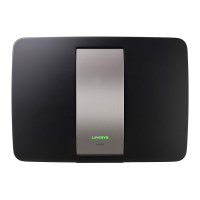29
Setting Up: Advanced
Linksys EA-Series
How to improve security using the built-in firewall
Why would I need to change my security settings? By default, the firewall
settings in your router have been optimized for most home environments, so
no changes are needed. The SPI (Stateful Packet Inspection) firewall is enabled
by default. In addition, anonymous Internet requests and IDENT requests are
filtered by default. All web filters are disabled, because enabling them may
cause problems for sites that depend on ActiveX controls, Java, or cookies.
Changing firewall settings
To change your firewall settings:
1.
Log into Linksys Smart Wi-Fi. (See “How to connect to Linksys Smart Wi-
Fi” on page 7.
2.
Under Router Settings, click Security. The Security page opens to the
Firewall tab.
3.
You can now change the following settings:
TIP
For more descriptions of each setting, click Help at the top of the
screen.
• Firewall: SPI firewall protection—This helps protect your local
network from Internet threats. This option is enabled by default.
On some router models, this setting is separated into IPv6 and IPv4
options so that each can be handled separately.
CAUTION
To help protect your network, you should keep this option enabled.
• VPN Passthrough:
• IPSec Passthrough – IPSec (Internet Protocol Security) is a suite of
protocols used to implement secure exchange of packets at the IP
layer. The VPN clients on the local network can establish an IPSec
VPN tunnel through the router. This option is enabled by default.
• PPTP Passthrough – PPTP (Point-to-Point Tunneling Protocol)
allows the PPP (Point-to-Point Protocol) to be tunneled through
an IP network. The VPN clients on the local network can establish
a PPTP VPN tunnel through the router. This option is enabled by
default.
• L2TP Passthrough – L2TP (Layer 2 Tunneling Protocol) enables
point-to-point sessions using the Internet on the Layer 2 level.
The VPN clients on the local network can establish an L2TP VPN
tunnel through the router. This option is enabled by default.
• Internet filters:
• Filter anonymous Internet requests—This filter blocks Internet
requests from unknown sources such as ping requests. This option
is enabled by default.
• Filter multicast—Multicasting allows a single transmission
to simultaneously reach specific recipients within your local
network. Select this option to block multicasting. This option is
disabled by default.
• Filter Internet NAT redirection—This filter prevents a local
computer from using a URL or Internet IP address to access the
local server. Select this option to enable the filter. This option is
disabled by default. On some router models, this setting applies
to IPv4 Internet only.
• Filter ident (Port 133)—This filter prevents port 133 from being
scanned by devices from the Internet. This option is enabled by
default.
4.
Click Save to save your changes.

